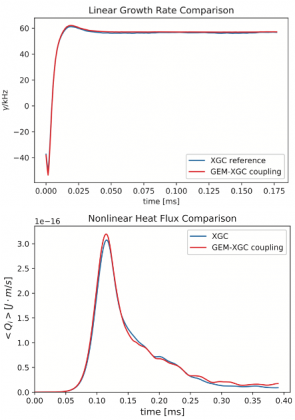
Achievement
Two existing particle-in-cell gyrokinetic codes, GEM for the core region and XGC for the edge region, have been successfully coupled in toroidal geometry, using a suitable spatial coupling scheme at the interface.
Significance and Impact
Spatial core-edge coupling is the first step toward building a. first-principle-based Whole Device Model (WDM), a critical need for predicting the phenomena of future fusion facilities such as ITER
Research Details
- Application-to-application exchange of charge density and electric potential occur at each Runge-Kutta phase, using memory-to-memory based data transport
- Oak Ridge contributions to this work were:
- providing memory to memory transport through ADIOS
- developing the code-coupling framework with EFFIS
- supporting and tuning performance of codes in that coupled environment
Citation and DOI
Cheng, J., Dominski, J., Chen, Y., Chen, H., Merlo, G., Ku, S.H., Hager, R., Chang, C.S., Suchyta, E., D'Azevedo, E. and Ethier, S. Spatial core-edge coupling of the particle-in-cell gyrokinetic codes GEM and XGC. Physics of Plasmas, 27(12):122510, 2020
doi: https://doi.org/10.1063/5.0026043
Overview
Computational Whole Device Modeling (WDM) is a critical need for understanding next-generation fusion experiments such as ITER, whose range of operating conditions are not achievable today. The modeling requires solving mutli-physics, where phenomena on different length and time scales are relevant. The Exascale Computing Project’s (ECP) WDMApp team is building a first-principles solution by coupling multiple applications, each of which solves a different regime of the physics. The first step is spatial core-edge coupling; here, we present successful measurements for an algorithm to couple the edge-code XGC with core-code GEM. In the overlap region, the composite distribution function solution is constructed as a linearly weighted average between the two regimes and requires and exchange of charge density and electric potential data between the two applications, which is implemented through memory-to-memory transfer. Because XGC and GEM use different meshes, interpolation is also needed, which is implemented in a linear field-following manner. Our results verify that the coupled solution is consistent with the XGC-only reference solution, that is, a more computationally intensive simulation in which XGC is used in the entire plasma volume.
Last Updated: January 19, 2021 - 12:24 pm